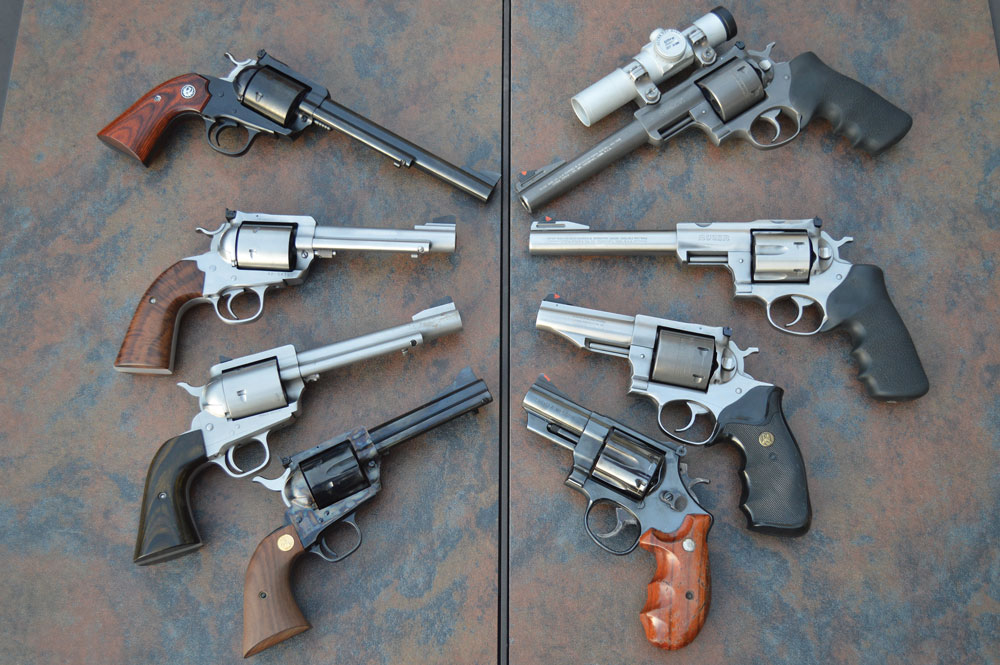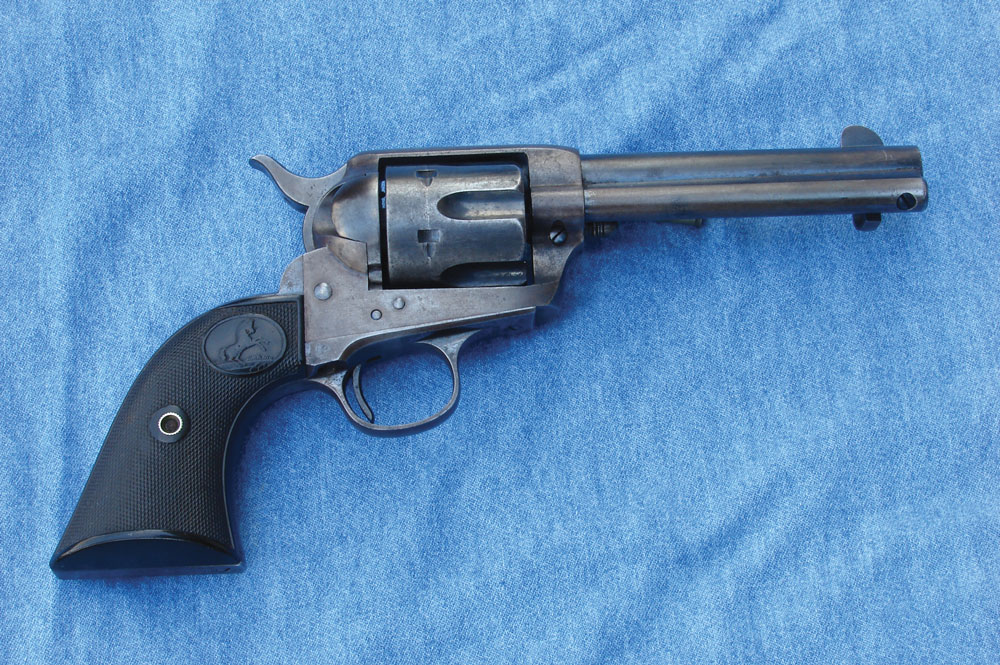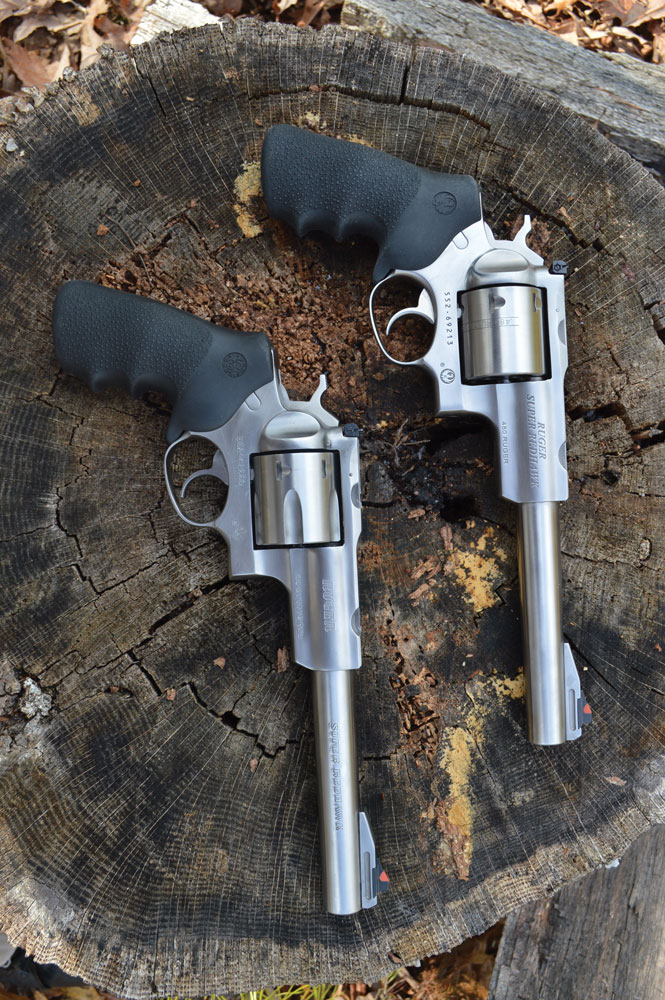

Revolvers come in many flavors, many shapes and sizes, and many different configurations. The two main platforms are the single action and the double action. Which one is best for you is ultimately a matter of preference. Which is most comfortable in your hand, and more importantly the revolver you can shoot most accurately, is the one you should choose.
Single and Double Action Differences
Single actions derive their name from the fact that they can only be fired by cocking the hammer and squeezing the trigger one shot at a time, whereas the double action can be fired in the same manner as the single action or simply by squeezing the trigger to fire – hence “double action.”
All modern day single-action revolvers are based, however loosely, on the Colt Single Action Army (SAA). So timeless was the design that it is still in wide use today. There are a number of manufacturers of single-action revolvers, including Ruger, Freedom Arms, Magnum Research, Uberti and Colt.
Double-action revolvers are available from Smith & Wesson, Colt, Ruger and Taurus on the new and used markets. Colt’s excellent Anaconda is no longer in production, but it can be found used and makes for an excellent choice for hunting or as a back-up weapon.
Both types of revolvers can be chambered in calibers adequate for big-game hunting and protective back-up duty, but they handle recoil differently. Double actions tend to transfer all of their recoil straight back into the web of your hand, while single actions have a propensity to exhibit barrel rise and are designed to roll upward (particularly in the case of single actions equipped with “plow handle”-type grips).

Know Your Intentions
Before the decision can be made, you will need to define the intended purpose of the revolver. Is this revolver going to be used as backup? Or is the revolver going to be employed as a primary hunting tool, possibly doubling as backup?
Why is this important? Simply because a primary hunting handgun can be fitted with a longer barrel than one that will strictly be used as a back-up revolver, and it might be sporting an optic like a scope or red dot-type sight. A revolver that is intended only for back-up duty may ride on your belt for years without ever being drawn and used, so it probably won’t have a very long barrel or an optic mounted up top, with more of a nod towards comfortable carry.
The external finish of the revolver is also something to consider when choosing. If the revolver will spend more time riding in a holster on your belt as backup, stainless steel may be the most durable finish. Not only does bluing typically wear off in a holster from rubbing, it is more vulnerable to rust when exposed to the elements—something to consider. Your local weather should also be a factor in helping you decide.
Double-Action Advantages
In the case of back-up work, a double-action revolver offers a couple of distinct advantages over its single-action counterpart, to include the ability to fire by simply pulling the trigger without pulling the hammer back, and the ability to open the cylinder and load and unload more easily compared to a single-action revolver where one round at a time can be loaded and unloaded.
Oddly enough, many who have double-action revolvers don’t shoot them double action (I would fall into this category of shooter). This sort of negates that “advantage” a bit.
That being said, I would rather have a double-action revolver if trapped underneath an animal trying to make a meal of me, as that advantage would surely become more than pronounced. As mentioned, the other advantage the double action holds over the single action is the ability to load and unload a cylinder at a much faster rate. Of course this virtue is only an advantage if one is in a situation where a speedy reload is necessary. I have yet to experience this need in the field.

Caliber Picks
Caliber choice in this discussion is a moot point as either configuration, as mentioned before, can be chambered in a significantly powerful caliber. I suggest that if hunting big game with a revolver, or carrying one in bear country for protection, one should choose the biggest caliber they can accurately shoot without a flinch or fear of recoil. I like to think of the .44 Magnum as the minimum reliable caliber and it is a good choice particularly if you do not reload, as there is an abundance of available factory ammunition for the popular caliber.
The old warhorse .45 Colt is perhaps the most overlooked, probably due to the rather weak factory load offerings (due to the many old .45 Colts that are in circulation). Loaded to its potential in a modern firearm (from Ruger, Freedom Arms or Magnum Research), there is little the .45 Colt cannot tackle, and some specialty ammo manufacturers offer modern, higher pressure .45 Colt loads like Grizzly Cartridge, Buffalo Bore Ammunition and Double Tap Ammunition.
Conclusion
You have two platforms to consider when choosing your revolver. My suggestion would be to first define its use, and second, figure out which one you can shoot the best. This is the one that will inevitably be the most comfortable in your hand and the one that will inspire the most confidence. There is no substitute for actually doing a side-by-side comparison to best help you in making this critical decision. I must confess that I like both, but I have found (for me) that the single action points more intuitively. They both have their advantages and disadvantages, but both will do the job reliably.
Editor's note, this article appeared in the February 13, 2014 edition of Gun Digest the Magazine.

Next Step: Get your FREE Printable Target Pack
Enhance your shooting precision with our 62 MOA Targets, perfect for rifles and handguns. Crafted in collaboration with Storm Tactical for accuracy and versatility.
Subscribe to the Gun Digest email newsletter and get your downloadable target pack sent straight to your inbox. Stay updated with the latest firearms info in the industry.

![Best Concealed Carry Guns In 2025 [Field Tested] Wilson Combat EDC X9S 1](https://gundigest.com/wp-content/uploads/Wilson-Combat-EDC-X9S-1-324x160.jpg)


![Best 9mm Carbine: Affordable PCCs [Tested] Ruger Carbine Shooting](https://gundigest.com/wp-content/uploads/Ruger-Carbine-Shooting-100x70.jpg)
![Best AR-15: Top Options Available Today [Field Tested] Harrington and Richardson PSA XM177E2 feature](https://gundigest.com/wp-content/uploads/Harrington-and-Richardson-PSA-XM177E2-feature-100x70.jpg)

Nice simple explanatory article, excellent work. I like that you mentioned the 45 Colt round, it is a versatile round, used in a wide variety of firearms. I have a Bond Arms Snake Slayer IV which shoots it, and also a S&W 460V. The 460V is certainly up to the task of Big Game with the 460 or 454 Casull, but again , the 45 Colt round can be used. The 45 Colt is actually a very comfortable load to shoot, even in a small gun like the Bond Snake Slayer IV and I have shot 325 gr 45 Colt Bear rounds out of it. Also have a Rossi Circuit Judge Rifle that shoots 410 and 45 Colt. The 45 Colt is more powerful energy wise than a 45ACP and similar to a 357, but slower.